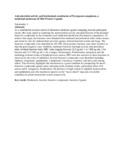Anti-microbial activity and biochemical constituents of Pycnoporus sanguineus, a medicinal mushroom of Mid-Western Uganda
Abstract
As a contribution towards search of alternative medicine against emerging resistant pathogenic strains,
this study aimed at exploring the antimicrobial activity and identification of the potential bioactive
compounds in the commonly used medicinal mushroom (Pycnoporus sanguineus). To achieve this
target, the fractions were obtained from methanol and petroleum ether crude extracts and tested in
vitro for antimicrobial activities against selected bacterial strains and fungi. The bioactive compounds
were identified by GC-MS. Gram positive bacteria were more sensitive to than the gram negative
ones. Similarly, methanol fractions had high activity than petroleum ether. Isolated fractions had a
MIC value ranging between 12.5 μg mL-1 to >200 μg mL-1 for bacteria and 12.5-100 μg mL-1 for a
fungus. Interestingly, Pseudomonas aeruginosa and the multidrug resistant strains of Staphylococcus
aureus, MD were also sensitive to these fractions as observed by the zones of inhibition. Several
bioactive compounds were identified including aliphatic compounds, naphthalene, 2-pentanone,
4-hydroxy-4-methyl- and fatty acids among others. This diversity highlights this mushroom as a
good candidate for prospecting for novel bioactive compounds against many emerging multi-resistant
strains, particularly those of S. aureus and P. aeruginosa. Furthermore, the presence of high content of
aliphatic hydrocarbons and naphthalene puts this mushroom species on the “myco-diesel” map and a
favorable candidate for potent insecticides search, respectively.
Key words: Mushroom, fraction, bioactive compounds, bacteria, Uganda

